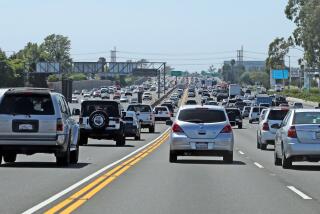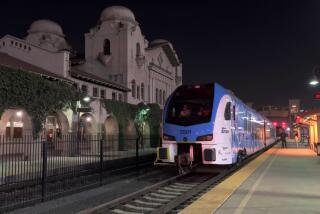Way off track
ON JAN. 26, 2005, AN APPARENTLY SUICIDAL motorist parked his SUV across train tracks near Glendale, causing a horrific accident that killed 11 passengers and injured 180 others. Today, a state Senate committee is scheduled to consider a bill that its sponsors say could help avert such tragedies in the future. The
committee should reject it.
A special committee on rail safety headed by Assembly Majority Leader Dario Frommer (D-Glendale) has considered the results of studies performed in the wake of the disaster and crafted a bill now before the Senate Committee on Transportation and Housing. The bill would force rail lines to close off the first 10 rows of the lead cars in so-called push trains, in which the train is pushed from behind by a locomotive rather than pulled, and end push-mode operations entirely in 2010.
The bill might soothe the grieving with a feeling that all those deaths had at least resulted in a law that would save lives in the future. More likely, however, is that the measure would be costly and result in reductions in rail service without necessarily improving safety.
A study by the Federal Railroad Administration found that push mode doesn’t result in more derailments than pull mode. Supporters of a ban say the study considered only the likelihood of derailment, not the extent of injuries. Data do show more deaths in crashes involving trains in push mode, but there have been too few incidents to reach firm conclusions. A final version of the report released Monday contained computer modeling of the Glendale crash and concluded that it would have been just as deadly with a locomotive in front.
Rail operators estimate that it would cost more than $200 million to buy enough locomotives to put them at both ends of California’s commuter trains, which could be necessary if push mode were banned. Other options could cost even more. For example, railroads could build “wye” tracks, which are configured like the letter Y and allow trains to reverse direction by performing something like a three-point turn. But a Metrolink spokeswoman says it would take a parcel of land the size of Dodger Stadium for a single wye, and Metrolink alone would need 21 of them. Even if the land were available, which it isn’t, it would be prohibitively expensive.
The state is obliged to pay the mandated costs of its legislation, but that’s a tricky proposition. It is notoriously difficult to get the Legislature to reimburse agencies and municipalities for the cost of complying with its laws. If rail services like Metrolink have to pay the cost, it may mean reductions in service.
Further, design improvements may be about to render the issue moot. Metrolink has ordered 87 new cars, scheduled to arrive by 2010, that are said to be far superior to current models, incorporating new safety features such as energy-absorbing technology and better seating configurations. If the safety difference between push and pull trains is murky now, it will get even murkier when these cars come online.
If the bill would produce measurable improvements in safety, it would be worth the price. There is no evidence that it would. To head off future crashes, the Legislature should focus on things that could actually make a difference, such as more barriers to keep cars off the tracks and more grade separations where roads and tracks meet. But the state’s transportation system should not be hobbled because of one man’s apparent attempt to commit suicide.
More to Read
Sign up for Essential California
The most important California stories and recommendations in your inbox every morning.
You may occasionally receive promotional content from the Los Angeles Times.










